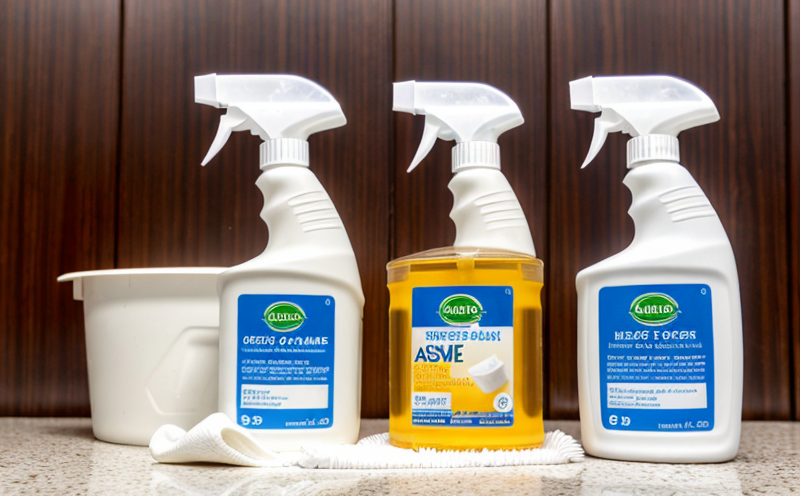EN 13697 Surface Disinfectant Activity Testing
The European Standard EN 13697:2004 specifies methods for determining the bactericidal activity of surface disinfectants. This standard is crucial for quality managers, compliance officers, R&D engineers, and procurement teams in the cleaning and hygiene product sector as it ensures that disinfectant products meet stringent microbiological efficacy requirements.
The test aims to assess how effectively a given disinfectant can kill bacteria on surfaces, which is critical for ensuring public health and safety. This service plays a vital role in validating the claims made by manufacturers about their disinfectants' effectiveness against specific microorganisms. The standard provides a framework that harmonizes testing procedures across different countries within Europe, promoting consistency and reliability.
EN 13697 involves several key steps: specimen preparation, inoculation with test organisms, application of the disinfectant, incubation period, and finally, post-treatment viability assessment. The standard specifies the use of specific strains of bacteria (e.g., S. aureus, E. coli) to ensure consistent testing conditions that reflect real-world scenarios.
The process is designed to simulate actual usage conditions as closely as possible, ensuring that the disinfectant's performance is accurately reflected in its label claims and potential effectiveness in the field. This approach helps manufacturers develop products that are both effective and safe for use on surfaces, thereby contributing to public health and hygiene standards.
The standard also includes guidelines for preparing test specimens, selecting appropriate dilutions of the disinfectant, and determining the contact time required for optimal efficacy. Compliance with this standard not only ensures product safety but also supports regulatory compliance in various jurisdictions, including Europe and beyond.
By adhering to EN 13697, companies demonstrate their commitment to producing high-quality products that meet international standards of hygiene and cleanliness. This is particularly important for manufacturers serving the healthcare, food processing, and hospitality industries, where surface disinfection plays a critical role in preventing the spread of infectious diseases.
The testing procedure outlined in EN 13697 ensures that disinfectants are effective against a range of pathogens, including both Gram-positive and Gram-negative bacteria. This comprehensive approach helps ensure that the products meet the stringent requirements set by regulatory bodies and industry standards, thereby enhancing trust among consumers and stakeholders.
Why It Matters
The importance of effective surface disinfectants cannot be overstated in today's world. With the ongoing challenges posed by infectious diseases such as influenza, norovirus, and more recently, SARS-CoV-2, ensuring that cleaning and hygiene products are efficacious against these pathogens is paramount.
- Public Health: Effective disinfectants play a crucial role in preventing the spread of infections, thereby protecting public health.
- Regulatory Compliance: Adherence to standards like EN 13697 ensures compliance with international regulations and guidelines.
- Consumer Trust: Reliable testing builds trust among consumers, who expect effective disinfectants that can be relied upon in critical situations.
- Industry Reputation: Consistent performance across products enhances the reputation of manufacturers within the cleaning and hygiene sector.
The success of any surface disinfectant lies not only in its chemical composition but also in how it performs under real-world conditions. This testing ensures that the product is both effective and safe, contributing to a safer environment for everyone involved.
Applied Standards
EN 13697:2004 focuses on determining the bactericidal activity of surface disinfectants. It specifies detailed procedures for conducting tests that assess the efficacy of these products against various pathogenic bacteria. This standard is designed to ensure that manufacturers produce disinfectants that are both effective and safe, thereby supporting public health initiatives.
The testing method outlined in EN 13697 involves several key steps:
- Specimen Preparation: Test specimens are prepared according to the standard's specifications, ensuring uniformity across tests.
- Inoculation: Bacterial cultures (e.g., S. aureus, E. coli) are inoculated onto the test specimens.
- Application of Disinfectant: The disinfectant is applied according to the specified protocol, ensuring that it remains in contact with the specimen for the required duration.
- Incubation Period: After application, the specimens are incubated under controlled conditions to allow bacterial growth and potential survival.
- Post-Treatment Viability Assessment: The effectiveness of the disinfectant is assessed by determining the viability of the bacteria post-treatment. This involves counting the surviving colonies after a specified incubation period.
This comprehensive approach ensures that the testing accurately reflects real-world scenarios, providing reliable data on the bactericidal activity of surface disinfectants.
Benefits
- Informed Decision Making: Quality managers and compliance officers can make informed decisions based on rigorous test results.
- Risk Mitigation: By ensuring that products meet stringent standards, manufacturers mitigate the risk of ineffective disinfection.
- Enhanced Reputation: Compliance with international standards enhances the reputation of both individual products and entire brands.
- Consumer Confidence: Reliable testing builds trust among consumers, who rely on effective disinfectants for their safety and health.
- Regulatory Compliance: Adherence to EN 13697 ensures that products meet the stringent requirements set by regulatory bodies.
- Improved Product Performance: Consistent performance across tests helps manufacturers refine their product formulations, leading to improved efficacy and safety.
The benefits of adhering to this standard extend beyond just meeting compliance; they contribute to creating a safer environment for consumers and stakeholders alike.





